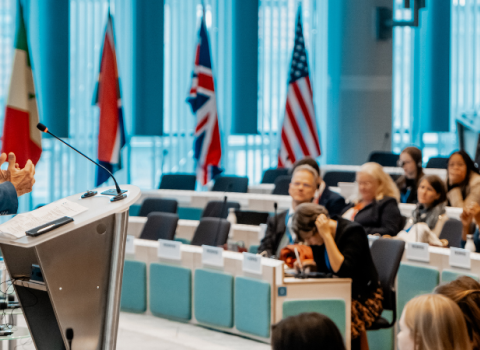Five years after PLAN S set out to make research free at the point of publication there’s progress to report. But the work is not finished and the pressure must be maintained, says the EU’s former Open Access envoy

Robert-Jan Smits is president of TU Eindhoven, former Open Access Envoy at the European Commission. Photo: International Science Council
It is exactly five years since twelve European research funding agencies supported by the European Commission presented the radical PLAN S to accelerate the transition to full and immediate Open Access to scientific publications.
For more than 30 years, scientists and science policymakers had agreed with the principle that research funded from the public purse should be Open Access, but progress had been slow. PLAN S aimed to turn principle to practice by putting the combined weight of some of Europe’s biggest funders of science behind the move to require all research they backed be freely available to all at the point of publication.
The rationale is crystal clear: knowledge generated with the support of the public purse should be accessible to society at large and not be locked behind paywalls, in effect requiring funding agencies to pay twice – to generate the knowledge and then to buy it back from large commercial publishers in the form of journal subscriptions.
The case for Open Access crystalised when COVID-19 spread rapidly across the globe and researchers mobilised to track the epidemiology of the virus and to develop therapies and vaccines. From day one, research results and data were shared and made available in real time by both academia and industry, to win the race against the clock.
Open Access helped beat the virus, begging the question of how it could be deployed to address other grand societal challenges we face, from climate change to food security and the energy transition to social inequality.
Year five progress report
The founding group of funding agencies cOAlition S has grown over the years. Today some 25 science funding agencies and charities, including the Gates Foundation, the World Health Organisation and the Howard Hughes Medical Institute, are members of the coalition.
The icing on the Open Access cake came on 25 August 2022 when the White House Office of Science and Technology (OSTP) issued a new Open Access policy mandating that federally-funded research be made available for free.
Meanwhile, in many countries, academic institutions and publishers have signed agreements to facilitate the transition to full and immediate Open Access. In most cases these include ‘hybrid journals’ with both subscription-based and Open Access articles, which over an agreed period of time will phase out subscriptions and in favour of Open Access papers.
New Open Access publishers and platforms have entered the market and as such increased the landscape of services - and enhanced competition. And last but not least, large commercial publishers have declared they are committed to becoming fully Open Access.
Remaining concerns
It may look as if full Open Access is just around the corner. But out of the four million scientific papers published each year, some 61% are still behind subscription paywalls.
Notably in the medical field, progress has been painfully slow. Only 31% of all cancer-related publications are Open Access. For cardiovascular and respiratory diseases the figures are 20% and 16% respectively. In climate change, only 40% of publications are Open Access.
I think progress has been slow because there are still some people who believe that Open Access is synonymous with those predatory journals that publish for a fee without providing peer review or editing services. There are others who deliberately keep this myth alive.
Second, many academic libraries are locked into subscription budgets and cannot afford to liberate funds for Open Access. In other words, the switch from ‘pay to read’ to ‘pay to publish’ is complex.
Third, there is much criticism across the board that the Article Processing Costs charged for publishing an Open Access paper are just too high. But this is also misguided, since for example, Gold Open Access provides much better value for money than subscriptions.
While subscriptions cost between €4,000 to €9,500 per article, the article processing cost of Open Access publishing is on average €2,500 per article, although there are exceptional cases where almost €9,000 is charged. However, it has to be acknowledged that over recent years there has been an increase in processing charges.
Fourth and perhaps most importantly, the Transformative Agreements mentioned above, have not yet delivered.
Staying the course
To make further headway, my view is that we should stay on course and adhere to the principles of PLAN S. This means being ruthless about the 2024 deadline for transformative agreements to deliver a transition to full and immediate Open Access.
In case of an agreement to align Europe’ s open access policy with the new OSTP guidelines - for which I make a strong plea - the deadline could exceptionally be postponed to 2025. In this context it is essential to stay robust and to monitor progress through the Directory of Open Access.
If increasing article processing costs create a bottleneck, there should be cap on them, as was foreseen under the original draft of PLAN S. It is in any case essential that more transparency is provided on the costs of academic publishing, be it subscription or Open Access based.
The last thing to do would be to change course – but this is exactly what I am afraid is happening. It was therefore very disappointing that in the Council conclusions of 23 May, Europe’s science ministers, while being unambiguous about their backing for Open Access, hardly mention PLAN S, and instead call for the support of ‘not-for-profit open access publishing platforms and models’.
With this, they have taken a ‘left turn’. I say this, not because outlets, such as Diamond Open Access and Open Access Europe platform, are not laudable and should not be supported. Rather, it is because these will not be the game changers that are desperately needed to arrive in due course at full and immediate Open Access.
The often-heard claim that Diamond Open Access is ‘free’ to all stakeholders distracts from the reality that there is always a price to be paid for quality Open Access publishing, be it by the funding agency, the academic institution or the individual researcher, through his or her grant or salary. Furthermore, 86% of Diamond Open Access journals publish fewer than 50 articles per year and therefore lack the necessary scale to make the difference.
It was also surprising that the science ministers gave the impression that they wished to exclude the large commercial publishers, which provide quality service to the science community. These key players in the world of scientific publishing just need to be forced to change their business model and embrace Open Access at a fair price. And this is what PLAN S is all about.
My plea to the scientists, science funding agencies, including the members of cOAlition S, and to science policymakers is to stick to the principles of PLAN S and stay the course. Taking a new path won’t speed things up. As the actor Will Smith once said, “There’s no reason to have plan B, because it distracts you from plan A.”
He probably meant PLAN S.
Robert-Jan Smits is president of TU Eindhoven, former Open Access Envoy at the European Commission and former director general of the Commission’s directorate for research and innovation.





 A unique international forum for public research organisations and companies to connect their external engagement with strategic interests around their R&D system.
A unique international forum for public research organisations and companies to connect their external engagement with strategic interests around their R&D system.